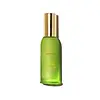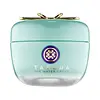What's inside
What's inside
 Key Ingredients
Key Ingredients

 Benefits
Benefits

 Concerns
Concerns

 Ingredients Side-by-side
Ingredients Side-by-side

Hordeum Vulgare Leaf Juice
EmollientMel
EmollientSimmondsia Chinensis Seed Oil
EmollientCitrullus Lanatus Seed Oil
EmollientGlycerin
HumectantGlyceryl Stearate Citrate
EmollientWater
Skin ConditioningPropanediol
SolventC13-14 Alkane
SolventAvena Sativa Kernel Oil
Skin ConditioningNigella Sativa Seed Oil
EmollientPyrus Malus Seed Oil
EmollientSantalum Spicatum Seed Oil
Skin ConditioningSqualane
EmollientBackhousia Citriodora Leaf Extract
AstringentSaccharide Isomerate
HumectantTasmannia Lanceolata Fruit/Leaf Extract
AntioxidantChlorella Vulgaris Extract
Skin ConditioningMagnolia Officinalis Bark Extract
AntimicrobialSalix Alba Bark Extract
AstringentSodium Hyaluronate
HumectantOlea Europaea Fruit Oil
MaskingArnica Montana Extract
Skin ConditioningBorago Officinalis Leaf Extract
Skin ConditioningCalendula Officinalis Flower Extract
MaskingMedicago Sativa Extract
TonicSpiraea Ulmaria Extract
AstringentSambucus Nigra Fruit Extract
AstringentSaccharomyces Ferment
Skin ConditioningPolyglyceryl-3 Stearate
EmulsifyingCaprylyl Glycol
EmollientHydrogenated Lecithin
EmulsifyingLysolecithin
EmulsifyingSclerotium Gum
Emulsion StabilisingGlyceryl Caprylate
EmollientXanthan Gum
EmulsifyingLauroyl Lysine
Skin ConditioningTocopherol
AntioxidantSodium Phytate
Pullulan
Phenethyl Alcohol
MaskingCitrus Limon Fruit Oil
AstringentOcimum Basilicum Oil
MaskingCitrus Aurantium Peel Oil
Citric Acid
BufferingSodium Citrate
BufferingLavandula Angustifolia Oil
MaskingAlcohol
AntimicrobialCymbopogon Flexuosus Oil
MaskingLactic Acid
BufferingFerula Galbaniflua Gum Extract
AntimicrobialLimonene
PerfumingLinalool
PerfumingCitral
PerfumingGeraniol
PerfumingFarnesol
PerfumingCitronellol
PerfumingHordeum Vulgare Leaf Juice, Mel, Simmondsia Chinensis Seed Oil, Citrullus Lanatus Seed Oil, Glycerin, Glyceryl Stearate Citrate, Water, Propanediol, C13-14 Alkane, Avena Sativa Kernel Oil, Nigella Sativa Seed Oil, Pyrus Malus Seed Oil, Santalum Spicatum Seed Oil, Squalane, Backhousia Citriodora Leaf Extract, Saccharide Isomerate, Tasmannia Lanceolata Fruit/Leaf Extract, Chlorella Vulgaris Extract, Magnolia Officinalis Bark Extract, Salix Alba Bark Extract, Sodium Hyaluronate, Olea Europaea Fruit Oil, Arnica Montana Extract, Borago Officinalis Leaf Extract, Calendula Officinalis Flower Extract, Medicago Sativa Extract, Spiraea Ulmaria Extract, Sambucus Nigra Fruit Extract, Saccharomyces Ferment, Polyglyceryl-3 Stearate, Caprylyl Glycol, Hydrogenated Lecithin, Lysolecithin, Sclerotium Gum, Glyceryl Caprylate, Xanthan Gum, Lauroyl Lysine, Tocopherol, Sodium Phytate, Pullulan, Phenethyl Alcohol, Citrus Limon Fruit Oil, Ocimum Basilicum Oil, Citrus Aurantium Peel Oil, Citric Acid, Sodium Citrate, Lavandula Angustifolia Oil, Alcohol, Cymbopogon Flexuosus Oil, Lactic Acid, Ferula Galbaniflua Gum Extract, Limonene, Linalool, Citral, Geraniol, Farnesol, Citronellol
Water
Skin ConditioningSaccharomyces/Rice Ferment Filtrate
Skin ConditioningDimethicone
EmollientPropanediol
SolventGlycerin
HumectantDiglycerin
HumectantDiphenylsiloxy Phenyl Trimethicone
Skin ConditioningCamellia Sinensis Leaf Extract
AntimicrobialCladosiphon Okamuranus Extract
Skin ConditioningPEG-9 Polydimethylsiloxyethyl Dimethicone
EmulsifyingGold
Cosmetic ColorantBelamcanda Chinensis Root Extract
Skin ConditioningRosa Multiflora Fruit Extract
MaskingHouttuynia Cordata Extract
Skin ConditioningSophora Angustifolia Root Extract
Skin ConditioningSodium Hyaluronate
HumectantLecithin
EmollientPistacia Lentiscus Gum
MaskingSodium Chloride
MaskingSodium Citrate
BufferingMica
Cosmetic ColorantTin Oxide
AbrasiveDimethicone/PEG-10/15 Crosspolymer
Dimethicone/Phenyl Vinyl Dimethicone Crosspolymer
Tocopherol
AntioxidantButylene Glycol
HumectantEthylhexylglycerin
Skin ConditioningDipropylene Glycol
HumectantParfum
MaskingAlcohol
AntimicrobialPhenoxyethanol
PreservativeLimonene
PerfumingLinalool
PerfumingCitral
PerfumingCI 77891
Cosmetic ColorantWater, Saccharomyces/Rice Ferment Filtrate, Dimethicone, Propanediol, Glycerin, Diglycerin, Diphenylsiloxy Phenyl Trimethicone, Camellia Sinensis Leaf Extract, Cladosiphon Okamuranus Extract, PEG-9 Polydimethylsiloxyethyl Dimethicone, Gold, Belamcanda Chinensis Root Extract, Rosa Multiflora Fruit Extract, Houttuynia Cordata Extract, Sophora Angustifolia Root Extract, Sodium Hyaluronate, Lecithin, Pistacia Lentiscus Gum, Sodium Chloride, Sodium Citrate, Mica, Tin Oxide, Dimethicone/PEG-10/15 Crosspolymer, Dimethicone/Phenyl Vinyl Dimethicone Crosspolymer, Tocopherol, Butylene Glycol, Ethylhexylglycerin, Dipropylene Glycol, Parfum, Alcohol, Phenoxyethanol, Limonene, Linalool, Citral, CI 77891
 Reviews
Reviews

Ingredients Explained
These ingredients are found in both products.
Ingredients higher up in an ingredient list are typically present in a larger amount.
Alcohol comes in many different forms. Different types of alcohol will have different effects on skin. This ingredient is usually an astringent alcohol.
These alcohols are drying on the skin. They may strip away your skin's natural oils and even damage your skin barrier. Astringent alcohols may also irritate skin.
Other types of astringent alcohols include:
According to the National Rosacea Society based in the US, you should be mindful of products with these alcohols in the top half of ingredients.
Any type of sanitizing product will have high amounts of alcohol to help kill bacteria and viruses.
Fatty alcohols come from plant oils such as coconut oil. These can help hydrate the skin and are non-irritating. Some fatty alcohols include cetyl and stearyl alcohol.
Learn more about AlcoholCitral is a fragrance and used to add a lemon-like scent to products. It is both naturally found in plants and created synthetically. In plants, it is commonly occurring in lemon myrtle, lemongrass, lemon tea-tree, lemon verbena, and other citruses.
The EU mandates Citral be listed separately as a fragrance. It is a known allergen and may cause contact dermatitis. Citral can also used as a masking ingredient.
The term 'fragrance' is not regulated in many countries. In many cases, it is up to the brand to define this term. For instance, many brands choose to label themselves as "fragrance-free" because they are not using synthetic fragrances. However, their products may still contain ingredients such as essential oils that are considered a fragrance.
The term 'citral' is a collective term for two geometric isomers: geranial/Citral A and neral/Citral B.
Learn more about CitralGlycerin is already naturally found in your skin. It helps moisturize and protect your skin.
A study from 2016 found glycerin to be more effective as a humectant than AHAs and hyaluronic acid.
As a humectant, it helps the skin stay hydrated by pulling moisture to your skin. The low molecular weight of glycerin allows it to pull moisture into the deeper layers of your skin.
Hydrated skin improves your skin barrier; Your skin barrier helps protect against irritants and bacteria.
Glycerin has also been found to have antimicrobial and antiviral properties. Due to these properties, glycerin is often used in wound and burn treatments.
In cosmetics, glycerin is usually derived from plants such as soybean or palm. However, it can also be sourced from animals, such as tallow or animal fat.
This ingredient is organic, colorless, odorless, and non-toxic.
Glycerin is the name for this ingredient in American English. British English uses Glycerol/Glycerine.
Learn more about GlycerinLimonene is a fragrance that adds scent and taste to a formulation.
It's found in the peel oil of citrus fruits and other plants such as lavender and eucalyptus. The scent of limonene is generally described as "sweet citrus".
Limonene acts as an antioxidant, meaning it helps neutralize free radicals.
When exposed to air, oxidized limonene may sensitize the skin. Because of this, limonene is often avoided by people with sensitive skin.
The term 'fragrance' is not regulated in many countries. In many cases, it is up to the brand to define this term. For instance, many brands choose to label themselves as "fragrance-free" because they are not using synthetic fragrances. However, their products may still contain ingredients such as essential oils that are considered a fragrance.
Learn more about LimoneneLinalool is a fragrance and helps add scent to products. It's derived from common plants such as cinnamon, mint, citrus, and lavender.
Like Limonene, this ingredient oxidizes when exposed to air. Oxidized linalool can cause allergies and skin sensitivity.
This ingredient has a scent that is floral, spicy tropical, and citrus-like.
Learn more about LinaloolPropanediol is an all-star ingredient. It softens, hydrates, and smooths the skin.
It’s often used to:
Propanediol is not likely to cause sensitivity and considered safe to use. It is derived from corn or petroleum with a clear color and no scent.
Learn more about PropanediolSodium Citrate is the sodium salts of citric acid. In skincare, it is used to alter pH levels and acts as a preservative.
Its main functions are to maintain the pH of a product and neutralize metal ions.
The acidity of our skin is maintained by our glands and skin biome; normal pH level of skin is slightly acidic (~4.75-5.5).
Being slightly acidic allows our skin to create an "acid mantle". This acid mantle is a thin barrier that protects our skin from bacteria and contaminants.
Learn more about Sodium CitrateSodium Hyaluronate is hyaluronic acid's salt form. It is commonly derived from the sodium salt of hyaluronic acid.
Like hyaluronic acid, it is great at holding water and acts as a humectant. This makes it a great skin hydrating ingredient.
Sodium Hyaluronate is naturally occurring in our bodies and is mostly found in eye fluid and joints.
These are some other common types of Hyaluronic Acid:
Learn more about Sodium HyaluronateTocopherol (also known as Vitamin E) is a common antioxidant used to help protect the skin from free-radicals and strengthen the skin barrier. It's also fat soluble - this means our skin is great at absorbing it.
Vitamin E also helps keep your natural skin lipids healthy. Your lipid skin barrier naturally consists of lipids, ceramides, and fatty acids. Vitamin E offers extra protection for your skin’s lipid barrier, keeping your skin healthy and nourished.
Another benefit is a bit of UV protection. Vitamin E helps reduce the damage caused by UVB rays. (It should not replace your sunscreen). Combining it with Vitamin C can decrease sunburned cells and hyperpigmentation after UV exposure.
You might have noticed Vitamin E + C often paired together. This is because it is great at stabilizing Vitamin C. Using the two together helps increase the effectiveness of both ingredients.
There are often claims that Vitamin E can reduce/prevent scarring, but these claims haven't been confirmed by scientific research.
Learn more about TocopherolWater. It's the most common cosmetic ingredient of all. You'll usually see it at the top of ingredient lists, meaning that it makes up the largest part of the product.
So why is it so popular? Water most often acts as a solvent - this means that it helps dissolve other ingredients into the formulation.
You'll also recognize water as that liquid we all need to stay alive. If you see this, drink a glass of water. Stay hydrated!
Learn more about Water